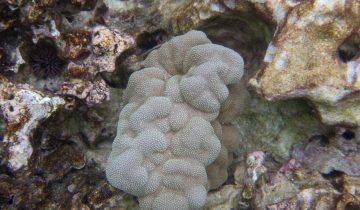Porites evermanni, commonly known as Evermann’s coral or branching Porites, is a species of stony coral belonging to the family Poritidae and the order Scleractinia. The genus name Porites comes from the Greek ‘poros‘, referring to the many small pores (corallites) visible on its surface, while evermanni honors the American ichthyologist Barton W. Evermann. This coral is characteristic of Indo-Pacific reefs, especially in the central and western Pacific Ocean, including areas near Hawaii. It is typically found in protected reef environments, such as lagoons and shallow reef slopes, at depths of up to 20 meters, where it contributes to reef structure.
From a morphological point of view, Porites evermanni forms massive colonies that tend to develop short branching or columnar structures. One of its most distinctive characteristics is the ‘hairy‘ appearance of the colonies, due to its polyps being extended during the day, which also gives it a particular coloration — usually mustard or light brown, though sometimes with greenish hues, especially with lighter tips. The corallites are small and densely packed, very similar to those of other species in the genus such as Porites australiensis and Porites columnaris. However, the consistent presence of extended polyps during daylight hours is a key visual clue for distinguishing Porites evermanni from those similar species.
In terms of feeding, Porites evermanni employs a mixed strategy. As a zooxanthellate coral, it maintains a symbiotic relationship with unicellular algae of the genus Symbiodinium, known as zooxanthellae, which live within its tissues. These algae perform photosynthesis and provide the coral with most of its nutritional needs, especially sugars and organic compounds. Additionally, Porites evermanni supplements its diet by capturing plankton and suspended organic particles in the water using its stinging tentacles. This external input becomes especially important under low-light conditions or during environmental stress events.
Reproduction in Porites evermanni is sexual and occurs through the release of gametes into the water column. After fertilization, the resulting planktonic larvae are dispersed by ocean currents before settling on the substrate and forming new colonies. This process is often influenced by environmental factors such as water temperature and lunar cycles. Like many reef-building corals, it can also reproduce asexually through fragmentation, which allows it to regenerate and expand locally.
An interesting aspect of Porites evermanni is its ecological role in coral reef ecosystems. Its branching structure provides shelter and colonization surfaces for numerous marine species, from invertebrates to small fish. Furthermore, its symbiotic relationship with zooxanthellae not only ensures its survival but also makes it a sensitive bioindicator of climate change. Like other corals, it may experience bleaching events if zooxanthellae are expelled due to thermal stress, although some populations of Porites have shown a degree of resilience to ocean warming. While not an abundant species, its presence is important for maintaining reef habitat biodiversity.
Photos:

